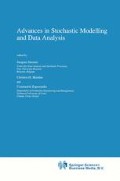Abstract
Using martingale methods, we find that the expected optimal exercise time of a perpetual, dividend-paying American call option contract is: the ratio of the time-independent stopping boundary to the risk-adjusted drift of the stock price process. This ratio is an analytical expression. Of independent interest is the computational simplicity of our derivation. Specifically, we use only the optional sampling theorem of martingale theory and elementary algebra. In contrast, the non-martingale approach requires tedious integration and solution of an ordinary differential equation.
I am particularly indebted to Profs. I. Karatzas and M. Tamarkin for advice and encouragement as well as to E. Henning for technical comments. Finally, this research was partially supported by the Institute for Mathematics and its Applications—University of Minnesota, with funds provided by the U.S. National Science Foundation.
Access this chapter
Tax calculation will be finalised at checkout
Purchases are for personal use only
Preview
Unable to display preview. Download preview PDF.
References
Bhattacharya, R. N. and E. C. Waymire. Stochastic Processes With Applications, Wiley, New York, 1990.
Chernoff, H. ‘Sequential Tests For the Mean of a Normal Distribution’, in: Proc. Fourth Berkeley Symp. Math. Statis. Prob., U. California Press, Berkeley, CA, I, 79–92 (1961).
Chung, K L. A Course In Probability Theory, 2nd ed., Academic Press, New York, 1974.
Collins, S. M. ‘The Expected Timing of EMS Realignments: 1979–83’, W.P. No. 4068, National. Bureau of Economic Research, Cambridge, Mass. (May 1992).
Durbin, J. ‘The First Passage Density of a Continuous Gaussian Process to a General Boundary’, J. Appl. Prob. 22, 99–122 (1985).
Durbin, J. and D. Williams. ‘The First-Passage Density of the Brownian Motion to a Curved Boundary’, J. Appl. Prob. 29, 291–304 (1992).
Feller, W. An Introduction to Probability Theory and Its Applications, Vol. I, 3rd ed., rev., Wiley, New York, 1968.
Garman, M. ‘Semper Tempus Fugit’, RISK, 5: 34–35 (1989).
Girsanov, I.V. ‘On Transforming a Certain Class of Stochastic Processes by Absolutely Continuous Substitution of Measures,’ Theory Probab. Appl., 5, 285–301 (1960).
Harrison, J.M. and S.R. Pliska. ‘Martingales and Stochastic Integrals in the Theory of Continuous Trading,’ Stochastic Processes and Applications, 11, 215–260 (1981).
Karatzas, I. ‘On the Pricing of American Options,’ Applied Mathematics and Optimization, 17, 37–60 (1988).
Karatzas, I. ‘Optimization Problems in the Theory of Continuous Trading,’ SIAM Journal of Control and Optimization, 27: 1221–1259 (1989).
Karatzas, I. and S.E. Shreve. Brownian Motion and Stochastic Calculus, 2nd ed., Springer-Verlag: New York, 1991.
Karlin, S. and H. M. Taylor. A First Course in Stochastic Processes, 2nd ed., Academic Press, New York, 1975.
Lindley, D.V. ‘Dynamic Programming and Decision Theory’, Applied Stats. 10, 81–90 (1961).
Martzoukos, S. H. and W. Teplitz-Sembitzky. ‘Optimal Timing of Transmission Line Investments in the Face of Uncertain Demand’, Energy Economics. 3–10 (1992).
McKean, H. ‘Appendix: A Free Boundary Problem for the Heat Equation Arising from a Problem in Mathematical Economics’, Ind. Mngmt. Rev., 6, 32–39 (1965).
Mikhalevich, S. ‘A Bayes Test of Two Hypotheses Concerning the Mean of a Normal Process’, Visnick Kiius’kogo Univ., (In Ukrainian). 1, 101–104 (1958).
Myneni, R. ‘The Pricing of the American Option’, The Annals of Applied Probability, 2, 1–23 (1992).
Ricciardi, L. M. and S. Sato. ‘First-Passage-Time Density and Moments of the Ornstein-Uhlenbeck Process’, J. Appl. Prob. 25, 43–57 (1988).
Shiryayev, A.N. Probability, Springer-Verlag, New York, 1984.
Srinivasan, S.K. and K.M. Mehata. Stochastic Processes, McGraw-Hill, New York, 1978.
Author information
Authors and Affiliations
Editor information
Editors and Affiliations
Rights and permissions
Copyright information
© 1995 Springer Science+Business Media Dordrecht
About this chapter
Cite this chapter
Yaksick, R. (1995). Expected Optimal Exercise Time of a Perpetual American Option: A Closed-form Solution. In: Janssen, J., Skiadas, C.H., Zopounidis, C. (eds) Advances in Stochastic Modelling and Data Analysis. Springer, Dordrecht. https://doi.org/10.1007/978-94-017-0663-6_2
Download citation
DOI: https://doi.org/10.1007/978-94-017-0663-6_2
Publisher Name: Springer, Dordrecht
Print ISBN: 978-90-481-4574-4
Online ISBN: 978-94-017-0663-6
eBook Packages: Springer Book Archive

